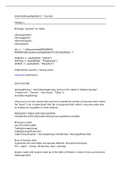Samenvatting
Samenvatting Research Training II Tutorials (BPN1104)
Alle codes van R studio die zijn uitgelegd in het vak Onderzoeksvaardheden II samengevat in een overzicht. All codes of R Studio that are used and explained in the course of Research Methods II.
[Meer zien]




